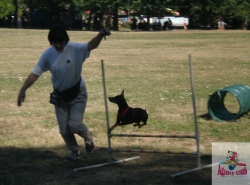Едно от кучетата ми беше диагностицирано ехографски с пиометра като единствената опция за лечение, която беше поставена пред мен беше кастрация на животното. Тогава изрично попитахме лекарите (чиито имена няма да споменавам) дали могат да се направят допълнителни изследвания, за да се потвърди диагнозата и дали това е единственото решение, защото държим да направим най-доброто за кучето независимо от финансовите разходи. Явно ветеринарните лекари не счетоха кучката ми за достатъчно ценен породен екземпляр, защото заявиха, че не може да се направи нищо друго и операцията е единственото решение (все пак не са кинолози и не очаквам да разпознаят дългогодишен клубен шампион). След изследвания при други лекари се разбра, че кучето въобще няма пиометра, но това е отделен въпрос... Както и да е, тогава се консултирахме с трима лекари, които работят съвсем отделно един от друг и всеки от тях предложи и медикаментозно лечение като естествено ни предупреди за възможните последици и вероятност в крайна сметка отново да се прибегне до кастрация.
Държа да благодаря на тези трима истински ветеринарни лекари! През годините се убедих, че наистина са професионалисти, а най-странното е, че за разлика от други свои колеги дават пълна консултация на стопаните, не си пазят "тайните на леченията" и не крият от никой какви лекарствата дават на животното, което лекуват.
Сега повечето лекари тук ще ми скокнат и ще почнат да ме убеждават, че медикаментозното лечение не е по-добрият избор при пиометра, обаче аз искам да ми бъде предоставен ИЗБОР (щом съществува такъв в чужбина) и смятам, че нормалното е лекарят да ме убеди, че кастрацията е по-правилното решение, а не да ме излъже, че тя е ЕДИНСТВЕНОТО решение, защото видиш ли аз съм прост стопанин на куче и нищо не разбирам от ветеринарна медицина.
И понеже стана въпрос за статистика, ето още малко информация (по мое скромно мнение само 18.9% рецидив на пиометрата една година след медикаментозното лечение е доста приемлив % на успешно лечение):
Цитат
with the Antigestagen Aglepristone
K. Trasch1, A. Wehrend and H. Bostedt
Address of authors:Clinic for Obstetrics, Gynaecology and Andrology of Large and Small Animals, Justus-Liebig University,
Germany, Frankfurter Str. 106, 35392 Gie?en, Germany; 1Corresponding author:E-mail:katjatrasch@yahoo.de
With 2 figures and 2 tables Received for publication:February 13, 2003
Summary
The aim of this study was to determine the therapeutic success
of the medical treatment of canine pyometra with the antigestagen
aglepristone and to document the recurrence rate in
relation to the time interval after treatment with antigestagens.
In 48 (92.8%) of the 52 treated bitches, healing could be
achieved within the first 3 weeks after the treatment had been
started. One bitch died as a result of renal insufficiency; in
three bitches there was no emptying of the uterus, so ovariohysterectomy
became necessary. In these three patients, ovarian
and endometrial cysts were present. Forty-one bitches
could be followed up for 3 months. Four animals developed a
recurrence (9.8%). In three bitches ovarian cysts and cystic
endometrial hyperlasia could be found intra operationem. The
development of 37 bitches could be followed for at least 1 year.
Seven animals developed a pyometra again (18.9%). Two
received a repeated treatment with aglepristone and have been
free from recurrence for over 12 months. In 37 animals data on
the subsequent sex cycles are available. In 22 bitches next heat
started at the expected time, in seven animals heat started too
early. In eight bitches the period of anoestrus was prolonged.
Five of the six bred bitches delivered at least one litter.The
presented data show that treatment of pyometra by aglepristone
results in a high healing rate. The recurrence rate can be
minimized by the selection of bitches without ovarian cysts and
cystic endometrial hyperplasia.
------------------------------------------------------------
Table 2. Recurrence and healing rates of bitches with pyometra up to
21 days, 3 month and at least 1 year after medical treatment with
aglepristone
n (%)
Short-term up to day 21
Total no. of bitches - 52 (100.0%)
Dead (on second day of treatment) - 1 (1.9%)
No emptying of the uterus - 3 (5.8%)
Initial emptying of the uterus - 49 (94.2%)
Healing rate - 48 (92.3%)
Medium-term up to month 3
Total no. of bitches - 41 (100.0%)
Recurrence rate - 4 (9.8%)
Long-term, at least 1 year
Total no. of bitches - 37 (100.0%)
Recurrence rate - 7 (18.9%)
----------------------------------------------------------------
Long-term success during, at least, 1 year after treatment
The further course could be observed in 37 bitches. Seven of
these animals developed a pyometra within 1 year (recurrence
rate 18.9%). In five of these animals, ovariohysterectomy was
performed by general veterinary practitioners. For this reason,
the findings of the ovaries and the uterus are unknown. In two
animals, the treatment with aglepristone was successfully
repeated; they did not show new signs of an uteropathy over
a period of, at least, 12 months (Table 2).
Data on the further reproductive behaviour of totally
37 bitches are available. In 22 bitches, the next heat started
at the expected time. The course of the heat in these animals
was normal. Five of these animals developed a pyometra in the
stage of dioestrus following oestrus. Seven animals showed
premature signs of subsequent heat. One of this bitches
developed a pyometra 8 weeks after oestrous behaviour. In
eight bitches the period of anoestrus was prolonged. In one
bitch the following heat was delayed by 6 months so that the
length of the interoestrus interval was 12 months. However, a
regulation to the normal cycle could be detected in seven
animals until the second heat after treatment. One bitch with
delayed interoestrus interval developed a pyometra.
Six of the bitches were bred during the time until the end of
the observation period, five delivered at least one litter of
whelps.


 Вход
Вход Регистрация
Регистрация Помощ
Помощ





 Горе
Горе Цитиране +
Цитиране +




 Почивайте в мир, мили ангели!
Почивайте в мир, мили ангели!





